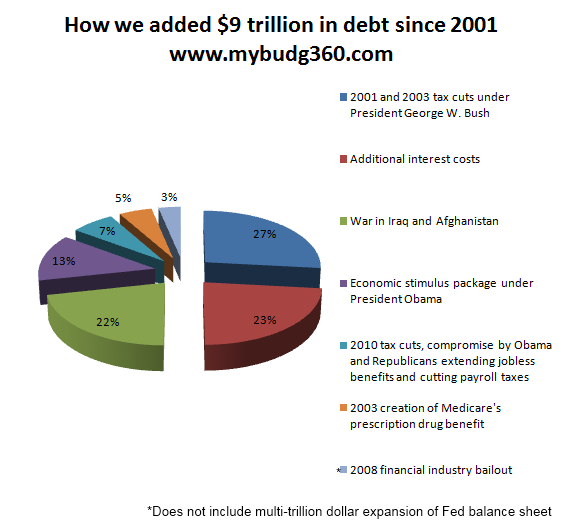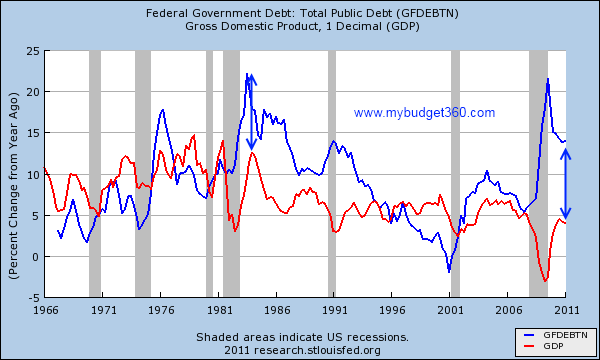Results 1 to 1 of 1
Thread Information
Users Browsing this Thread
There are currently 1 users browsing this thread. (0 members and 1 guests)
-
07-31-2011, 12:31 AM #1Senior Member


- Join Date
- May 2007
- Location
- South West Florida (Behind friendly lines but still in Occupied Territory)
- Posts
- 117,696
How to spend $9 trillion in 10 years. How in the financial w
How to spend $9 trillion in 10 years. How in the financial world did we end up with over $14 trillion in Federal government debt?
Posted by mybudget360
If we do a slow rewind back to 2001 U.S. debt stood at $5.8 trillion. This today would seem like a bargain. So how in the world did we end up with the current $14.3 trillion figure in a matter of ten years? People like to ignore history but if you donât know where your money is going then you are going to have massive holes in your budget. The fact of the matter is both political parties have setup a system where money is filtered up to the top one percent while the middle class wilts on a vine. This is the new economic system where wealth is distributed by political will while the working and middle class is forced into debt serfdom if they want to have any attempt at being middle class. Want a college education? It is virtually impossible to go to school without taking out onerous loans. Want to buy a home? Forget saving money when you can put it on tab and take on ludicrous amounts of debt that will set you closer to foreclosure down the road. Over the last decade the government has spent over $9 trillion and has put it on the national books. Let us examine what the biggest expenses were over this last decade.
Where did the $9 trillion go?

The three biggest expenses that pushed the national debt to over $14.3 trillion from $5.8 trillion are:
-2001 and 2003 tax cuts: $1.6 trillion
-Additional interest costs: $1.4 trillion
-War in Iraq and Afghanistan: $1.3 trillion
These are by far the three largest line items so why is it that we hear politicians and Wall Street bankers going after Social Security payments as a key place to balance the big debt that we have? If we look at the above, it doesnât seem like Social Security is the largest reason for the U.S. debt running amok. In fact, out of the three top contributors to the increase in debt, the only item on the table at the moment is taxes and somehow this is garnering very little traction. Any sensible person is going to realize that we are going to have to cut and raise taxes to get the balance sheet back into equilibrium.
Much of what is going on right now is political theatre. Yet one thing is clear. The middle class is going to get hammered by either option because the amount of debt we have taken on over the last decade is simply amazing. Think about this. In 2001 we had $5.8 trillion and somehow over one decade we more than doubled that amount. Keep in mind the above is only factoring the banking bailouts as costing $200 billion but we all know that the Federal Reserve has done a shadow bailout and has increased its own balance sheet to over $2.8 trillion. Debt is piling up on debt. http://www.mybudget360.com/federal-rese ... nce-sheet/
The velocity at which we are growing debt is stunning:

This is an interesting way at looking at the increase in government debt. We are comparing the annual changes in both GDP and government debt. Youâll notice that in the 1960s and the early 1970s that GDP was typically outpacing public debt in terms of year over year increases. This is good. You want to see your economy growing faster than your debt accumulation. But look at the mid-1970s and youâll suddenly see government debt surpassing GDP growth. The 1980s look horrible when measured this way. Federal government debt was increasing at a much faster pace than GDP growth. This was an era of âdeficits donât matterâJoin our efforts to Secure America's Borders and End Illegal Immigration by Joining ALIPAC's E-Mail Alerts network (CLICK HERE)


 LinkBack URL
LinkBack URL About LinkBacks
About LinkBacks




 Reply With Quote
Reply With Quote

Most Americans Support Using The Military To Conduct Mass...
04-29-2024, 09:14 PM in illegal immigration News Stories & Reports